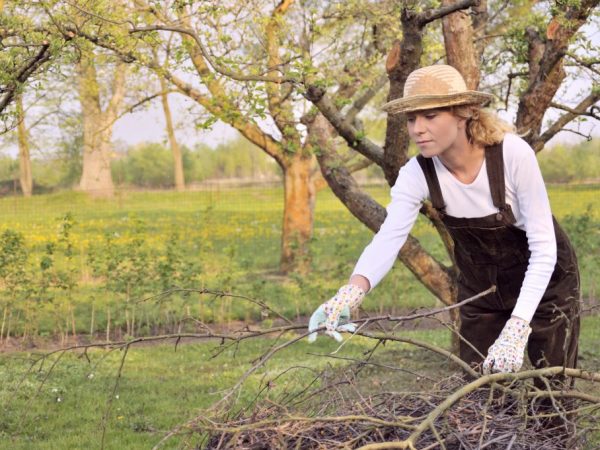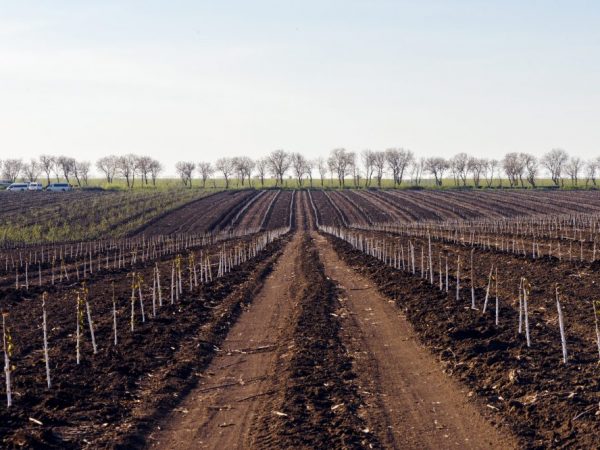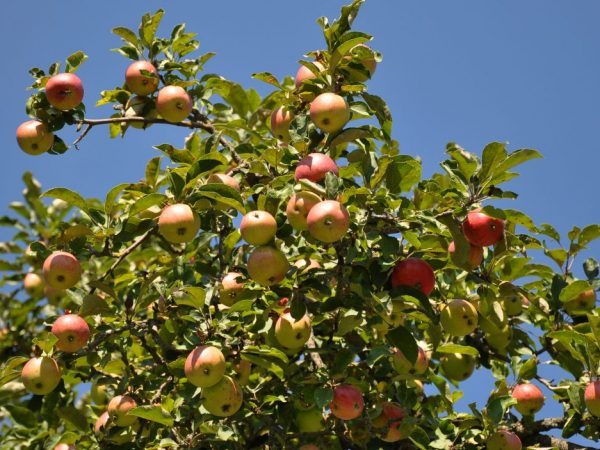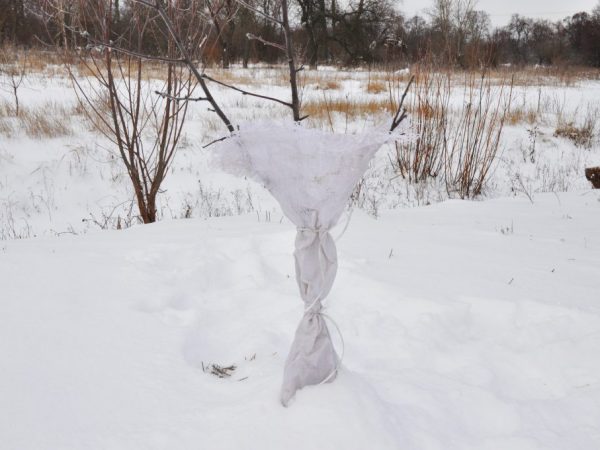Autumn care of the apple tree
Caring for an apple tree in autumn involves preparing the horticultural culture for winter. The main focus of gardeners is on feeding and processing against pests and diseases. Compliance with the basic rules allows you to avoid common mistakes in the preparatory process.
- Autumn pruning
- Whitewashing of trunks
- Autumn feeding and watering
- Top dressing
- Watering
- Horticultural processing
- From parasites
- From disease
- Cleaning of vegetation
- Pre-winter horticultural shelter
- Timing
- Technologists
- Features of care for different regions
- Middle zone of Russia
- central Russia
- Ural and Siberia
- How to avoid mistakes

Autumn care of the apple tree
Autumn pruning
Autumn pruning of an apple tree is one of the important points in preparing for winter.
This method allows you to reduce the load from the tree crown, and in the future - to avoid breaking off branches under the weight of snow.
The procedure is planned 3 weeks before the first frost (this time is enough for the slices to drag on, and the branches do not subsequently freeze);
Wherein:
- pruning branches, shortening young shoots and living branches in a first year, two-year-old apple tree and trees aged 3-4 years - by the length, in trees aged 5-7 years - by 1/3 of the length, in old apple trees (over 7 years) - up to ½ length;
- for thinning the tree crown, the branches intersecting with each other are shortened;
- young shoots that have appeared over the summer are cut from the trunk and from the superficial roots;
- topping branches and those that grow downward or away from the trunk are cut out;
- completely remove broken branches that have mechanical damage and signs of disease and pest attacks.
Pruning apple branches in the fall is one way to rejuvenate a mature tree.
Use a sharp garden tool and cut at an acute angle. The cut site is treated with an antiseptic solution and covered with garden varnish or oil paint.
Whitewashing of trunks
Whitewashing the apple tree trunk in the lower part is also an important aspect of autumn care. The procedure allows you to protect the garden culture from frost breaks, protects pests and infections from settling in the tree bark and creates an obstacle to sunburn when the first rays of the sun appear in spring.
The tree bark is preliminarily cleaned, freeing the trunk from dead debris, under which parasites and their larvae often settle. Before stripping, the trunk is moistened so as not to damage living tissues during the removal of the bark.
Better cleaned after heavy rainfall.
When everything is done, the apple tree can be whitened.
Autumn feeding and watering
Caring for apple trees in autumn includes two mandatory procedures: feeding and watering.
Top dressing
Pre-winter feeding begins 2-3 weeks after harvest. It replenishes the energy expended by the tree and provides mineral nutrition for the coming winter.
They feed apple trees in autumn at the same time as digging the soil, introducing fertilizing complexes, which include potassium and phosphorus.
Watering
Autumn watering is required if the summer is dry. Moistening the soil before the onset of winter increases the frost resistance of the garden culture.

The last watering is carried out in October
A sufficient amount of moisture should be absorbed by the trees before the onset of frost, therefore, they try to carry out the final irrigation of the soil around the apple tree trunk around October.
Horticultural processing
To properly prepare the apple tree for winter, you need to provide protection against pests and diseases.
Such events are carried out on dry and sunny days, strictly after the leaves fall, when the trees go into a state of dormancy, and the buds close, preventing toxic chemicals from entering the tissue cells. If precipitation falls within 3 days after the spraying, the procedure must be repeated.
From parasites
To ensure protection of apple trees from adult parasites and their larvae, spraying with pesticides and other drugs that have a destructive effect on them allows. Among the agents often used for these purposes are copper and iron vitriol, which are preliminarily diluted in warm water heated to 40'C, and then diluted with cold water to the required concentration.
The application rate depends on whether the garden crop has been affected:
- for healthy apple trees 200-300 g per 10 liters of water;
- for diseased trees, the concentration is higher - 400-500 g per 10 liters of water.
From disease
Treatment with urea or others with a similar composition of fungicidal and insecticidal complex effects helps to create a garden culture pre-winter protection against viral, fungal and bacterial diseases. Spraying is carried out after the final harvest of the apples and the complete fall of the leaves.
Application rates depend on whether the garden crop has been susceptible to diseases:
- when the apple trees were not sick, 200-300 g of urea per 10 liters of water is enough;
- trees affected by infections are treated with a more concentrated solution of urea - 500-700 g per 10 liters of water.
In the fight against scab, powdery mildew, black crayfish and fruit rot, spraying with iron sulfate is also used.
The application rate is the same as for pest control. In this case, it is permissible to use ferrous sulfate with urea at the same time, preparing a tank mixture (200 g of each component per 10 liters of water).
Cleaning of vegetation
Cleaning the vegetation preserved after the summer and autumn leaf fall allows not only to clean the surrounding area, but also to prevent the preservation of the larvae of harmful insects, fungal spores and pathogens of bacterial and viral infections in the fallen leaves and small branches.
Along with fallen leaves and dry branches, rotten apples are also subject to harvesting from the garden area in autumn, which often act as a wintering place for pathogens. They should be removed from the soil and plucked from the apple trees.
Harmful insects and pathogens hiding in plant debris for the winter retain their vital activity and, when warmth comes, in spring they begin active reproduction and development.

After harvesting, the tree begins to prepare for wintering.
Remove plant debris and other debris from the soil within a radius of 1.5 m from the place where the tree grows.
Pre-winter horticultural shelter
Warming is a mandatory procedure for preparing for winter for both adults and young apple trees. Thanks to this, you can protect them from the upcoming frost and keep them healthy.
Timing
They begin to cover the apple trees after the trees have completely finished the process of sap flow and the onset of complete rest. This usually occurs at a time when the ambient temperature drops to -10'C.
Technologists
The root system and the lower part of the trunk are subject to shelter for adult trees, for this:
- pre-loosen the soil around the trunk circle;
- the roots on the surface are covered with peat, sawdust or manure;
- in the lower part of the trunk, a bulk hillock is formed with a height of 0.35-0.4 m, around it, when snow falls, a snow slide will form, which will serve as additional insulation of the tree.
Young seedlings planted in spring do not have time to get stronger and often suffer from winter frosts. They should be covered with material that is wrapped around the trunk and secured with tape. Suitable:
- several paper layers;
- spunbond;
- roofing material;
- burlap or canvas fabric.
Some gardeners do it with their own hands to insulate the trunks with the help of a spruce or reed.
In addition, for the winter, young seedlings are tied to a support installed next to them, which makes it possible to protect them from scrapping under the influence of winds and snow.
Features of care for different regions
The procedure for preparing an apple orchard for winter differs in individual areas of Russia.
Middle zone of Russia
Many gardeners do not insulate the garden culture for the winter and do not cover it with improvised means, limiting themselves during autumn care only to top dressing, pruning and watering. The warm climate of the middle zone allows not to use covering material and not to create additional conditions for protection from frost.
However, more careful attention in these regions should be paid to treatments against pests and pathogens, because in warm climates with high humidity, the risk of parasite infestation of apple trees and the appearance of diseases increases significantly.
central Russia

Apple trees should be insulated for the winter.
The moderate climate of Central Russia makes it possible to successfully grow different varieties of apples, observing the basic rules of caring for horticultural crops.
It is necessary to additionally protect trees from frosty winters, which often occur in Moscow, Nizhny Novgorod, Smolensk and other regions.
The garden culture should be insulated, especially this rule applies to immature seedlings.
To prepare for winter and take care of the garden in Central Russia, they begin immediately after harvesting, starting with mineral dressings. At the same time, they try to treat trees with chemicals until the first days of November, while the ambient temperature is positive.
Ural and Siberia
Frosty winters in the Urals and Siberia require careful autumn care from gardeners: it is necessary to cover the apple tree, while the height of the trunk insulation should be at least 1.0-1.5 m from the soil surface.
For these regions, it is preferable to choose varieties that are resistant to winter cold, for example, Souvenir of Altai, Gornoaltaisky, etc.
The height of the warming hills around the trunk circle of a plant made of manure, sawdust or peat should be at least 0.35 m. A columnar sapling is often completely covered with polyethylene or burlap.
Starting from the first snowfalls, snow is thrown off to the trunk circle, which is additionally compacted. The snow cover will act as an effective protection of the root system from cold weather.
How to avoid mistakes
A typical mistake is the desire of inexperienced gardeners to leave fallen leaves and small branches in order to create additional heating of the apple tree root system for the winter period.
It is permissible to use the remains of vegetation as a method of warming only when it has been pre-treated from pests, their larvae, fungal spores and pathogens of bacterial and viral diseases.
Decay of foliage under a layer of snow contributes to the creation of favorable conditions for the active vital activity of pathogenic bacteria.
Another common mistake is the incorrect selection of apple varieties in relation to the climatic conditions of the growing region. This leads to frequent disturbances of the tree bark (frost breakers), which cannot withstand frost.
In areas with severe winters, apple trees cover almost the entire length of the trunk.
Competent care of the apple tree allows you to protect it from freezing and preserve it throughout the winter without losing productivity and immunity.

